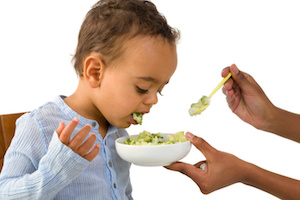What is Feeding Therapy?
A child needs adequate motor planning within their mouth to chew food safely and move the food from front to back appropriately.

When is “picky eating” a problem?
When a child feels unsafe while, eating, they will develop habits and compensatory strategies in order to gain control. A child may limit the size or texture of foods they are willing to tolerate in order to feel comfortable and safe while eating. When these limitations become of concern for a parent and/or pediatrician, feeding therapy if often recommended.
What are the goals of feeding therapy?
- Advice from newborn through school-age regarding mealtime behaviors
- Ideas on how to encourage the sights, sounds, touch, smell, and taste of food
- Equip families with knowledge and strategies to use during mealtime
How do I get my “picky eater” to eat?
- Making the mindset change from a “picky eater” to an “exploring eater” through positive reinforcement and an easy-going approach!
Why would a child need a feeding therapy evaluation?
Does your child…
Overreact or underreact to certain types of food
Shudder, gag, or spit up when attempting certain foods
Stay away from certain types of foods
Become fearful when trying new foods
Insist on eating certain food brands
Have difficulty eating outside the home
Limits food to a specific temperature
Prefer bland foods and refuses most savory or intense flavors
Craves intense flavors
Over-chews foods
Under-chews food and attempts to swallow large pieces
Overstuffs mouth
Chase a bite of food with liquid consistently
Dips everything into condiments
Spits food out after chewing

How often and for how long does feeding therapy last?
Most feeding therapy sessions are 45 minutes to one hour once per week however this may alter depending upon a child’s needs.
